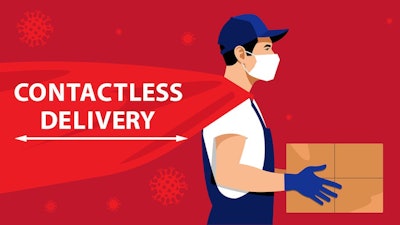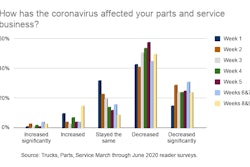
The changes, many of which were made abruptly with little guidance or time for preparation, were seen at the time as the first and best line of defense against the contagion. By focusing on social distancing and cleanliness, businesses found themselves committing to procedures they otherwise never would have considered.
And yet nearly three months later, as the virus is slowly brought under control and pockets of the world begin to reopen, many of the measures implemented at the outset of the pandemic appear unlikely to be lifted.
COVID-19 unquestionably forced changes to regular business operations most companies wouldn’t have proactively implemented, such as mandatory work-from-home orders and the closure of store fronts, but it also necessitated the widespread adoption of other, subtler workplace changes that are likely to become standard operating procedures for decades to come.
Within trucking’s aftermarket and dealer channels, COVID-19’s impact will last far longer than the virus.
Unquestionably the biggest change in the parts, service and equipment sales spaces since the outset of the coronavirus pandemic has been the dramatic adoption of alternative communication methods to replace face-to-face interaction.
In service garages, where customers have for decades brought their equipment to shops and directly interfaced with service writers and technicians about their concerns, nearly all diagnostic assessments and ongoing repair discussions are now being conducted over the phone or via service event management portals.
Vision Truck Group has used the latter, ASIST by Decisiv, within its service operations for more than a decade. Director of Service Operations Travis Brown says Vision’s early commitment to ASIST has proven useful during the pandemic because the company was already paperless, and wasn’t forced to suddenly scale up its usage of virtual communication tools like so many other service shops.
“Because of the position we were already in, we were much better equipped to handle this,” he says. “We were already communicating remotely with customers and everyone in our shops could do their jobs without face-to-face interaction.”
While speaking to a group of dealers now onboarding ASIST during a recent webinar, Brown said it was clear other service shops wished they had adopted the technology earlier, with one even stating, “It’s a shame it took a pandemic for the rest of us to get on board.”
And communication hasn’t just been altered between service providers and end users. In the body shop and collision sector, many shops are finding the virtual communication with claims adjusters preferable to the old-fashioned way, where shops would write up an estimate for work and then wait for several days for an adjuster to arrive and evaluate the repair.
“I can remember having to wait a week or more for an independent appraisers to just show up here,” says Rodney Rowland, manager, collision and paint center, Lakeside International Trucks. “Now my goal is to turn an estimate in 24 hours or less.”
Decisiv Director of Marketing Mark Wasilko believes once that time has been reclaimed, no one involved in a service event will want to give it up.
“We have the ability to automate a broken process and exchange information seamlessly between dealers, fleets and OEs,” Wasilko says. “We can improve triage times by 70 percent and dwell times by more than 20 percent. Those are huge gains.”
 Contactless delivery is being shown to reduce paperwork and increase driver efficiency.
Contactless delivery is being shown to reduce paperwork and increase driver efficiency.Another change forced by COVID-19 unlikely to disappear with the virus is contactless customer service, such as no-contact deliveries and order receivals. With customers no longer able or willing to enter parts facilities and sign for deliveries due to social distancing guidelines, dealers and distributors across North America have instituted touchless delivery drop-offs — where parts are placed at a customer’s door and then the customer is notified via phone, email or push notification — and sanitized pickup locations outside their own buildings for customers to receive their parts.
Repair operations are offering similar services, with Brown noting Vision is now offering pickup and drop-off of customer equipment (along with necessary disinfecting upon pickup and delivery) for service events for customers who do not want to come to one of the dealer’s six facilities.
Though minor changes in the grand scheme, these simple alterations to regular business practices are producing efficiency gains throughout the parts distribution channel for dealers, distributors and supplier parts distribution centers alike.
“We’re noticing our drivers are getting back to the store an hour earlier than normal on delivery runs because they’re not stopping and chatting with customers along the way,” said John Sadler, president, Sadler Power Train, in a conversation with TPS last month.
In-store interactions are changing too. Though only 10 percent of parts and service operations had been forced to close by state orders according to our May Trucks, Parts, Service reader survey, a substantially higher number of parts businesses voluntarily closed their showrooms or reduced occupancy rates to ensure employee and customer safety. Those that remain open do so with rigorous safety procedures in place, such as the removal of counter stools and use of barriers to keep customers 6 ft. from employees, and mandatory disinfecting of surfaces touched by customers during a transaction.
Most believe these safety precautions will remain in place for some time. Cleanliness is going to be priority for a while.
“We’re hopeful things will open up soon, but we’re also very cautious about what’s coming,” Darren Barnes, president, Crump Truck & Trailer Works, told TPS last month.
Then there’s business travel. Before the onset of the pandemic, there were thousands of sales associates, account managers and professional trainers on the road in the trucking industry every day. The first two groups were tasked with uncovering new customers, strengthening existing customer relationships and supporting product lines in the marketplace; the third group provided essential education for dealer, distributor and service shop associates, as well as end users.
The reopening of the country offers hope these professionals will be able to resume their work soon, but there’s no guarantee the number of workers who hit the road in the coming weeks will be equal to the number who were pounding the pavement every day in March. Many aftermarket parts suppliers have recently enhanced their online training capabilities to remain connected and engaged with their dealer and distributor partners. The online training has been well received by the suppliers and customers, and at a substantially lower cost to the suppliers than on-site instruction.
Yet the absence of direct interaction also comes with its drawbacks.
Online training generally requires a narrow approach to a topic in order to ensure the entirety of the subject can be covered in a short period of time, while on-site instruction enables trainers to cover issues in greater depth and answer student questions in real time.
It also can be tough to sell customers without the flexibility of a conversation — email marketing is a one-way street.
“I think at a certain point everyone becomes a little tired of it,” says Joe Krieger, territory manager, Enders & Associates. “It can be hard when every [supplier] is emailing the same messages, or at least similar messages, every day. You want your message to be dynamic and well received; not the same as what everyone else is doing.”
Dealers and distributors also must not overlook customer experience. Customers are going to expect changes introduced in recent months that benefited them to stick around — particularly the aforementioned streamlining of service diagnostics and event communication, improved parts and service pickup and delivery options and even e-commerce for parts ordering.
“I think COVID has shown us all how critical it is to be efficient,” says Wasilko. “We’re realizing there are tools out there that can make our everyday experiences easier.”











